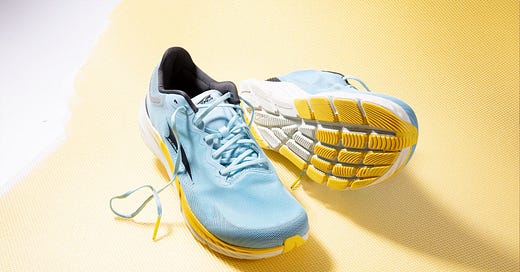Great Product. Bad Framing. No Traction.
A lesson in storytelling, positioning, and why emotional resonance is everything.
I've run thirteen marathons in Altra shoes. When people ask me why I'm so loyal to this brand, I don't start with the technical specs. I tell them about the morning I realized I'd been running wrong my entire life.
But last week, I heard an Altra podcast ad that completely missed the magic behind why I love these shoes and recommend them to everyone.
The ad opened with some variation of: "Altra's zero-drop platform and foot-shaped toe box provides superior biomechanical efficiency for natural running form." It sounded like a medical device commercial. I actually thought it was a joke at first—like someone was parodying how badly running brands talk to actual runners.
They could have opened with: "Tired of your knees hurting after every long run?" Instead, they chose technical jargon.
Look, I love this company. I've probably converted a dozen friends to Altra over the years. But when I explain it to them, it sounds nothing like that ad.
How I Actually Recommend Altra
When friends ask about my shoes, I usually start with: "Do your knees hurt after long runs?" Because honestly, that's the gateway question. Almost every runner I know has knee issues, and most assume it's just part of the sport.
Then I tell them: "These shoes let your foot land the way it's supposed to—flat instead of heel-first. No more slamming your heel down and sending that impact straight up to your knees."
Or: "Remember when you were a kid running barefoot on the beach? Your knees never hurt then, right? That's what these feel like, but you can wear them on concrete."
The toe box thing comes next: "Plus your toes can actually spread out like they're supposed to. It's like going from a cramped airplane seat to business class, but for your toes."
I might mention zero-drop if they seem curious about the mechanics, but honestly? Most people stop listening after "your knees won't hurt."
The technical stuff comes last, if at all. Engineering specs sound impressive in a lab. But runners just want to know: will I hurt less tomorrow?
The Story They Should Be Telling
Most runners have the same frustrating experience: knee pain that gets worse with every mile, conventional running shoes that force heel-striking and send shock waves up your legs, and the growing fear that maybe they're just "not built for distance."
We've all been told this is normal. Ice after runs, ibuprofen before them, and eventually accepting that running long distances means living with chronic pain.
But there's this whole philosophy about how humans evolved to run—barefoot, naturally, the way indigenous peoples still do. As outlined in the famous book Born to Run, for millions of years, we ran without cushioned heels or motion control. Then the running industry convinced us we needed increasingly complex shoes to fix problems those same shoes had created.
Altra could own the story of runners rediscovering what we lost. Of that first pain-free long run after switching to natural form. Of realizing that knee injuries aren't an inevitable part of the sport—they're a side effect of fighting all the unnatural support companies try to market to you.
Instead, they're reading from a spec sheet.
Altra's missed opportunity reveals something bigger: most companies fundamentally misunderstand what they're really selling.
The Frame Changes Everything
You're listing features when runners just want to know: will my knees stop hurting?
That question? That's your entire marketing strategy right there.
What Most Brands Miss
Altra has the best story in running and they're burying it under jargon. They could own the narrative of liberation from an industry that broke us, but instead they're talking about platforms and efficiency.
Imagine if they'd opened with this instead:
"Tired of your knees screaming at you after every long run? What if I told you the problem isn't your age, your training, or your genes - it's probably your shoes. For millions of years, humans ran without heel cushioning. Then the running industry convinced us we needed it. Altra makes shoes the way your feet were designed to work..."
Instead, they chose biomechanical efficiency.
When I wear Altras, I don't think about zero-drop platforms. I think about that first 20-miler where my knees didn't hurt at mile 19. I think about finally understanding that running shouldn't be a war of attrition against your own body. I think about discovering that what I thought was "just getting older" was actually just wearing the wrong shoes.
That's the frame that matters. The feeling itself, not the technology that enables it.
Your Frame Check
So let me ask you this: If someone overheard you describing your product the way Altra described theirs, would they immediately understand why it matters to real humans?
Or would they think you were reading from a spec sheet?
Here's your homework: Next time you're at a coffee shop, explain your product to a friend. Not pitching it - just casually explaining why you love it. Listen for the moment when your voice changes, when you get excited. That's where your frame lives. That's the question that makes people lean in.
The frame is the product. Because the same running shoe becomes completely different depending on whether you call it "biomechanical efficiency" or "pain-free running." The meaning that lives in your customer's head? That's what you're actually selling.
Thirteen marathons and one terrible podcast ad taught me this: people buy stories that solve emotional problems. Features that solve technical problems? Those gather dust on spec sheets.
That terrible podcast ad taught me something: even a brand I love can completely miss what makes me love them. Don't let that be you.
Elan is the founder of Off-Menu, a brand studio for startups. He's also logged more miles in Altras than most marketers log in meetings.




